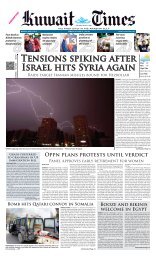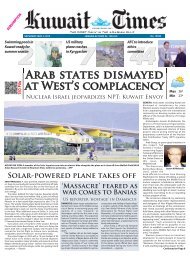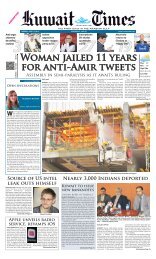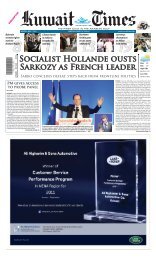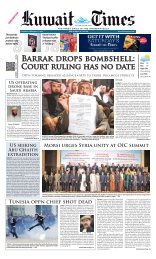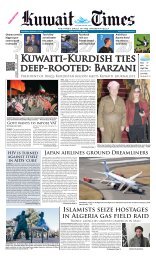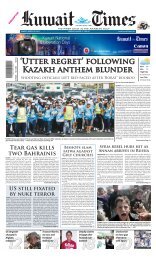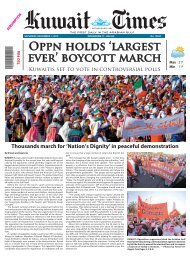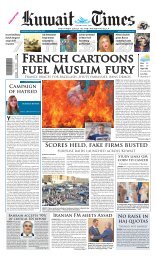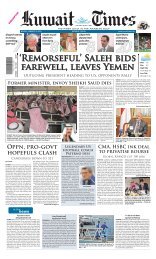NEw SARS-likE viRUS EMERGES iN MidEASt - Kuwait Times
NEw SARS-likE viRUS EMERGES iN MidEASt - Kuwait Times
NEw SARS-likE viRUS EMERGES iN MidEASt - Kuwait Times
You also want an ePaper? Increase the reach of your titles
YUMPU automatically turns print PDFs into web optimized ePapers that Google loves.
FREEPORT: Protest signs hang on the fence outside a camp set up by Sensata<br />
Technologies workers in Freeport, Illinois. —AFP<br />
Workers beg Romney to<br />
stop Bain outsourcing<br />
FREEPORT: Being told to train his<br />
replacement was humiliating and surreal,<br />
but Tom Gaulrapp said the worst part<br />
was when the plant’s US flag was taken<br />
down before the Chinese engineers<br />
arrived. Gaulrapp decided it was time to<br />
take a stand against outsourcing and the<br />
man he blames for the loss of his job:<br />
Republican White House hopeful Mitt<br />
Romney, who founded the private equity<br />
firm that owns the Freeport, Illinois auto<br />
parts plant.<br />
Romney’s ties to Bain Capital have<br />
burdened the Republican nominee’s<br />
hopes of winning the November 6 election<br />
as Democrats unfavorably paint him<br />
as a corporate raider who pioneered the<br />
outsourcing of US jobs to countries with<br />
lower labor costs. Romney denies the<br />
charge, but his claim to be a man who<br />
could revive the economy and boost the<br />
prospects of American workers rings hollow<br />
here.<br />
Gaulrapp thinks it would only take a<br />
phone call from the candidate who’s<br />
vowed to create 12 million jobs in the<br />
United States to save the 170 jobs at<br />
Sensata Technologies that are about to<br />
leave this already economically<br />
depressed town of 26,000. “What we’d<br />
like is a miracle,” Gaulrapp, who has<br />
worked at the plant for 33 years, said<br />
with a sigh that acknowledged how<br />
unlikely it is that his wish will be granted.<br />
“We’d like Mitt Romney to come to<br />
Freeport, see what this is doing to this<br />
community, and contact his friends that<br />
run Bain Capital and say ‘this is absolutely<br />
the wrong thing to do’ and save our jobs.”<br />
The Romney campaign declined to comment<br />
on the situation at Sensata, but a<br />
spokeswoman contacted by AFP noted<br />
that the former Massachusetts governor<br />
retired from Bain in 1999 and his investments<br />
there are controlled by a blind<br />
trust, effectively nullifying his links to the<br />
firm. Romney’s campaign recently set up<br />
a website-business.mittromney.comdefending<br />
his record at Bain and the<br />
“thousands” of jobs he saved or created<br />
by “fixing companies that were broken<br />
and giving new companies a shot at success.”<br />
“A Taste of the Romney Economy”<br />
But the situation in Freeport is a classic<br />
example of how what’s best for a<br />
company is not always what’s best for<br />
American workers, said Freeport Mayor<br />
George Gaulrapp, who is no relation to<br />
Tom. “You can’t keep sending your jobs<br />
offshore and still have a middle class,”<br />
said the mayor.<br />
Plant worker Pam Lampros, 53, is worried<br />
she’s going to lose her home so<br />
investors like Romney can make a bigger<br />
profit. “It just hurts after so many years of<br />
hard work and dedication,” said Lampros,<br />
a 34-year veteran at the non-unionized<br />
plant who had hoped to retire from<br />
Seaport delay highlights shaky Vietnam economy<br />
HANOI: All that remains of a plan by<br />
Vietnam to build a major deep-water<br />
port is 114 exposed pilings trailing<br />
into the South China Sea and a barge<br />
full of rusty machinery. Foreign<br />
investors stayed away from the $3.6<br />
billion project and the indebted stateowned<br />
company overseeing it bungled<br />
the job. Earlier this month, the<br />
government accused the company of<br />
“financial incompetence” and suspended<br />
the project. The prospects for<br />
ever reviving it are dim. The abandoned<br />
port in Southern Vietnam<br />
stands as a symbol of the inefficiency<br />
of the country’s Communist rulers,<br />
and the need to reform a massive web<br />
of state-owned enterprises weighing<br />
down a once-booming economy.<br />
Critics say it also shows how<br />
provincial governments and stateowned<br />
companies are allowed to pursue<br />
expensive, misguided and often<br />
corruption-laced infrastructure projects<br />
that result in riches for the few,<br />
but not economic growth that would<br />
benefit the country of 87 million people.<br />
The government is asking foreign<br />
and domestic investors to bankroll its<br />
flagship Van Phong port now that the<br />
there. “It’s for corporate greed, more or<br />
less.” Sensata, which is majority-owned<br />
by Bain Capital, purchased the automotive<br />
sensors unit from Honeywell for<br />
$140 million in cash in January 2011.<br />
With annual revenues of $130 million<br />
and valuable patents, the unit was a<br />
good buy. But with 75 percent of the revenue<br />
generated in Asia, it made sense to<br />
ship production to Sensata’s facilities in<br />
China, the Netherlands-based company<br />
said. “It’s better to be closer to one’s customers,”<br />
Sensata spokesman Jacob Sayer<br />
told AFP, citing transportation and other<br />
logistical advantages.<br />
Sayer acknowledged that the decision<br />
to shift production to China is “an unfortunately<br />
event” for Freeport and said he<br />
understands why it could be “difficult” for<br />
the workers to train their replacements.<br />
He has no idea why-or if-the US flag was<br />
removed before the Chinese engineers<br />
and technicians arrived. “We didn’t<br />
request it. I can tell you that,” Sayer said,<br />
adding that the company has been leasing<br />
the facility from Honeywell and has<br />
no involvement in grounds maintenance.<br />
The workers have had nearly two<br />
years to prepare for the plant closure.<br />
Some have found new jobs and those<br />
who remained were given retention<br />
bonuses to help keep operations going<br />
until the last pieces of equipment are<br />
shipped elsewhere. They got riled up in<br />
June when Romney visited nearby<br />
Janesville, Wisconsin and talked about<br />
how jobs were his top priority-at the<br />
same time they were being told to train<br />
their Chinese replacements. After<br />
months of pursuing Romney’s campaign<br />
with protests and petitions, the Sensata<br />
workers set up camp in the fairgrounds<br />
across the road from the plant on<br />
September 12 in hopes of drawing more<br />
attention to their cause.<br />
In a nod to both the “Hoovervilles” of<br />
unemployed workers that sprung up<br />
during the Great Depression and the<br />
Occupy Wall Street movement, about a<br />
dozen people have since been sleeping<br />
in tents staked into the cold, hard<br />
ground. Mark Schreck, 36, a registered<br />
Republican, even brought his children a<br />
couple of times.<br />
“This isn’t a Republican issue or a<br />
Democrat issue, this is an American<br />
issue,” he said, noting it is the second<br />
time his job has been outsourced to<br />
China, despite both operations being<br />
profitable-just not profitable enough.<br />
“We’re in trouble. I’m not that old and<br />
when I grew up American industry and<br />
technology was huge. My folks and my<br />
uncles all worked in good jobs and<br />
retired from them,” Schreck said as he sat<br />
by a smoking campfire on the windy fairgrounds.<br />
“It’s hard to grasp how bleak it<br />
is out there. I’ve been looking for work<br />
since last January and I’m not finding<br />
any.” —AFP<br />
Vietnam National Shipping Lines, or<br />
Vinalines, is out of the picture. But<br />
analysts say that’s unlikely because<br />
the project, which was slated to have<br />
37 wharves, isn’t near any important<br />
manufacturing bases in the region<br />
and was impractical from the start.<br />
A better option, they said, would be<br />
developing road and rail around ports<br />
in greater Ho Chi Minh City and also<br />
developing a deep-water port near the<br />
northern city of Hai Phong. A proposed<br />
large port near Hai Phong has spurred<br />
controversy lately over escalating costs<br />
and potential dredging problems. Vu<br />
Tu Thanh, Vietnam representative for<br />
the Washington-based US-ASEAN<br />
Business Council, said Vietnam has lost<br />
the reputation it enjoyed a few years<br />
ago for being among the most attractive<br />
destinations for investment in Asia.<br />
Would-be investors, he said, want the<br />
government to push through largescale<br />
economic reforms that will weed<br />
out the most inefficient state businesses.<br />
“There’s nothing inherently<br />
wrong about having state-owned<br />
enterprises involved in big, capitalintensive<br />
projects like ports,” said<br />
Thanh, whose advocacy group repre-<br />
23 BUSINESS<br />
sents American companies in<br />
Southeast Asia. “The problem is: Do<br />
you have the right SOE there?”<br />
“The typical answer in Vietnam is:<br />
You don’t.” Vietnam has a coastline of<br />
3,200 kilometers (1,988 miles) - longer<br />
than American’s west coast and a<br />
prime location on the South China<br />
Sea, which includes some of the<br />
world’s biggest shipping channels. But<br />
its lack of linked-up infrastructure puts<br />
its ports at a competitive disadvantage<br />
compared with long established global<br />
trade hubs such as Singapore,<br />
Shanghai and Hong Kong.<br />
As a result, manufacturers here are<br />
often forced to first send containers<br />
to those larger ports from where they<br />
are then shipped to Europe and<br />
North America. Businessmen and<br />
observers say the port sector is a<br />
good example of how political<br />
patronage and entrenched corruption<br />
are undermining the country’s<br />
development.<br />
Vietnam has about three dozen<br />
seaports and several high-quality terminals<br />
that welcome international<br />
shipping lines, but no major port<br />
with swift connections to efficient<br />
roads and rail. “All the coastal<br />
provinces want a deep-sea port,” said<br />
Nguyen Xuan Thanh, director of public<br />
policy programs at the US-funded<br />
Fulbright Economics Teaching<br />
Program in Ho Chi Minh City. “The<br />
central government needs political<br />
support from these provinces, so<br />
they don’t say no to these proposals.”<br />
“Everybody wants a piece of the<br />
action,” he said. In 2010, state-owned<br />
ship builder Vinashin came close to<br />
collapse with debts of $4.5 billion,<br />
leading to a sovereign credit rating<br />
downgrade and sounding the alarm<br />
on a major pressure point in Vietnam’s<br />
economy.<br />
Last month, police arrested two<br />
former senior executives at one of the<br />
country’s largest banks. The banking<br />
industry has run up massive bad<br />
debts in recent years, many of them<br />
made to state-owned companies.<br />
Vinalines has also come under<br />
scrutiny. In March, police arrested several<br />
of its executives and accused<br />
them of mismanagement in the purchase<br />
of a floating dock that resulted<br />
in losses of about $5 million. In May,<br />
government inspectors issued a<br />
TUESDAY, SEPTEMBER 25, 2012<br />
German business mood<br />
worst since mid-2009<br />
Economists warn of Q3 contraction<br />
BERLIN: German business sentiment dropped<br />
for a fifth straight month in September, raising<br />
fears of recession as companies struggled<br />
with what they said was the worst economic<br />
outlook since mid-2009. Germany’s relative<br />
resilience to the euro-zone debt crisis has<br />
been steadily fraying as its firms see falling<br />
demand for their products from European<br />
partners and signs of a slowdown in other<br />
markets. The European Central Bank’s plan for<br />
potentially unlimited government bond-buying<br />
has raised hopes on financial markets of<br />
an end to the most acute phase of the crisis,<br />
but that optimism has not spread to company<br />
boardrooms.<br />
The Munich-based Ifo institute’s monthly<br />
sentiment index reached its lowest since early<br />
2010 and Ifo economist Klaus Wohlrabe told<br />
Reuters the outlook was the worst since May<br />
2009. “Today’s Ifo index shows that German<br />
companies remain sceptical about the economic<br />
impact of (ECB president) Mario<br />
Draghi’s magic,” ING Bank economist Carsten<br />
Brzeski said. “Despite fears of a looming eurozone<br />
break-up clearly fading away, German<br />
businesses are downscaling their expectations.<br />
The German economy could see a contraction<br />
in the third quarter.”<br />
Ifo said its business climate index, based on<br />
a monthly survey of some 7,000 firms, fell to<br />
101.4 in September from 102.3 in August,<br />
defying expectations for a slight rise to 102.5<br />
in a Reuters poll of 45 economists. In its<br />
monthly report, the Bundesbank said the<br />
domestic economy was robust, but added it<br />
saw signs of “weaker dynamics” and “great<br />
uncertainty”.<br />
Foreign trade could be hit more strongly<br />
than before by developments in the euro<br />
area, the central bank added, also pointed to<br />
the labour market, where the rise in employment<br />
is slowing as companies become less<br />
willing to hire. Dutch business confidence also<br />
fell in September to -6.7 points from -4.6 in<br />
August, other data showed yesterday, adding<br />
to signs that the euro-zone’s stronger “core”<br />
economies are succumbing to the downturn.<br />
While they have not been punished by<br />
debt markets like much of the euro’s southern<br />
half, both Germany and the Netherlands have<br />
slashed public spending to secure the future<br />
of public finances. “The drop in Ifo business<br />
confidence is a potent reminder that the outlook<br />
for the German and euro-zone<br />
economies still hangs in the balance,” said<br />
Holger Schmieding, German economist at<br />
investment bank Berenberg. “Further policy<br />
steps to contain the euro crisis may be needed<br />
for the euro-zone to turn the corner.”<br />
Tough cuts<br />
While the German economy steamed<br />
ahead in the first three months of the year,<br />
saving the euro-zone from recession by growing<br />
0.5 percent, it lost momentum in the second<br />
quarter, with growth slowing to 0.3 per-<br />
cent. Dragging on the Ifo index in September<br />
was a sharp decline in sentiment among manufacturers,<br />
although companies in retailing<br />
and wholesaling reported a slightly brighter<br />
mood. Last week’s ZEW survey also showed<br />
German analyst and investor morale picked<br />
up in September.<br />
Industrial group Bosch and steelmaker<br />
ThyssenKrupp , have announced plans to<br />
introduce “Kurzarbeit” or government-subsidised<br />
short-time work at German plants. The<br />
index would have fallen further had it not<br />
been for a ruling by Germany’s constitutional<br />
court on Sept 12 in favour of the ratification of<br />
Europe’s permanent bailout fund. Half of the<br />
responses in the survey came after the ruling.<br />
The Finance Ministry warned in its monthly<br />
report last Friday that data pointed to weaker<br />
growth in the remainder of the year. Many<br />
economists are now predicting a contraction<br />
for the third and possibly the fourth quarters.<br />
Another forward-looking indicator, the<br />
Purchasing Managers Index (PMI), last week<br />
showed Germany’s private sector shrank for a<br />
fifth month, and a separate index for the eurozone<br />
showed that the ECB’s bond-buying plan<br />
had so far failed to inspire any major improvement<br />
in business at ailing euro-zone companies.<br />
However, economist Gerd Hassel said he<br />
believed news of the ECB’s bond-buying plan<br />
had yet to fully sink in. “I’m optimistic that the<br />
Ifo climate index will rise again in the coming<br />
months,” he said. —Reuters<br />
Dreamliner brings jolt of excitement to flying<br />
TOKYO: As the Boeing 787 Dreamliner<br />
nosed upward into the clouds, the<br />
engines purred rather than roared. The<br />
recent All Nippon Airways domestic<br />
flight was anything but a routine route<br />
for many passengers. A year after ANA<br />
launched the world’s first 787 flights,<br />
Japanese travelers are still agog.<br />
Passengers craned necks to glimpse the<br />
big bird at Haneda Airport. And as they<br />
boarded, many whipped out digital<br />
cameras and iPhones and started shooting<br />
pictures like paparazzi setting upon<br />
Justin Bieber.<br />
In an era when flying is more about<br />
diminished expectations than adventure,<br />
airlines like ANA hope the technologically<br />
advanced midsize 787 will put<br />
some of the thrill back into the air at<br />
35,000 feet. So far, it seems to be working.<br />
“Many, many people are excited,”<br />
ANA flight attendant Shoko Yoshimura<br />
said aboard the recent 787 flight from<br />
Tokyo to Fukuoka on the island of<br />
Kyushu. Silicon Valley travelers will get<br />
their chance to board the Dreamliner<br />
when ANA begins its five-day-a-week<br />
787 route between Mineta San Jose<br />
(Calif) International and Tokyo’s Narita<br />
International airports on Jan 11. San<br />
Francisco International spokesman<br />
Michael McCarron said “two or three”<br />
carriers he declined to identify expect to<br />
start flying 787s out of that airport next<br />
year. But an Oakland (Calif) International<br />
Airport official who asked not to be<br />
identified said none of its carriers has<br />
indicated plans to use 787s in the near<br />
future.<br />
The 787’s high-ceiling cabin glows<br />
with pastel colors. Its spacious interior,<br />
increased cabin pressure and higher<br />
humidity are aimed at making crossthe-world<br />
journeys less taxing on bodies.<br />
And its fuel-sipping technology and<br />
ability to cover long distances allows airlines<br />
to tear up old business models that<br />
left smaller market airports like San Jose<br />
out of their flight paths. It hasn’t been<br />
profitable for airlines to try to fill larger<br />
aircraft - such as a 368-passenger<br />
Boeing 777-300 - flying into secondary<br />
airports. ANA is outfitting its long-haul<br />
787 with only 46 business-class and 112<br />
economy seats. “It gave us the opportu-<br />
nity to open up new markets - even secondary<br />
markets,” said Kohei Tsuji, ANA’s<br />
director of network planning. Once ANA<br />
gets more 787s delivered - it has so far<br />
received 13 of the initial order of 55 - the<br />
airline plans to expand its San Jose-<br />
Tokyo service to seven days a week, he<br />
said. ANA anticipates having 20<br />
Dreamliners by the end of March.<br />
According to Bloomberg, ANA agreed<br />
Friday to buy 11 more Dreamliners for<br />
delivery beginning in 2018, bringing the<br />
total of ordered planes to 66. The plane<br />
has quickly become the envy of the<br />
industry. In a spring survey by ANA of<br />
800 passengers who had flown its 787<br />
between Tokyo and Frankfurt, Germany,<br />
98 percent said they wanted another<br />
chance to fly the Dreamliner, no matter<br />
what airline’s logo was on the plane. A<br />
quarter of them said they’d go out of<br />
their way to board the new aircraft<br />
again.<br />
“The 787 offers an emotional experience,”<br />
said Robert Herbst, an aviation<br />
industry consultant who operates<br />
AirlineFinancials.com. “That’s something<br />
passengers haven’t had for a very long<br />
time.” It offers perks that even those<br />
who sit in the back of the plane in economy<br />
can enjoy. Passengers stepping<br />
onto an ANA 787 are greeted by flight<br />
attendants standing in the chamber-like<br />
entrance with a high ceiling - creating a<br />
sense of airy space rather than the feeling<br />
of entering a cramped tube.<br />
“It’s a very beautiful plane and very<br />
comfortable to ride on,” said one passenger<br />
on the Tokyo-Fukuoka flight,<br />
who would only give his first name,<br />
Takahiro. He was particularly taken with<br />
the lavatory enhancements - toilets<br />
equipped with bidet spray options. Two<br />
bathrooms also have windows.<br />
“The bathrooms are especially wonderful,”<br />
the 29-year-old gushed. “The<br />
FUKUOKA: With rainbow lighting on the ceiling, passengers<br />
disembark from an ANA Airlines Boeing 787 Dreamliner. —MCT<br />
ceilings are high. You feel so much air. It<br />
feels good. And it’s environmentally<br />
kind.” Overhead bins are so high that<br />
steps are built into the base of seats so<br />
flight attendants can reach the compartments<br />
without the risk of falling<br />
onto passengers. The plane boasts one<br />
of the largest galleys in the sky.<br />
The plane doesn’t have shock<br />
absorbers to smooth out bumpy air and<br />
you still have to fasten your seat belt.<br />
But as the 787 lifts off, the rumble of<br />
engines is muffled. The twin engines are<br />
equipped with noise-reducing chevrons<br />
- jagged edges on the nozzles of the<br />
engines - that lower the sound of jet<br />
blasts by controlling how air passes<br />
through and around them.<br />
“It was quiet. I was surprised,”<br />
Gonzalo Guerri, a Chilean tourist visiting<br />
Fukuoka, said after he gathered his luggage<br />
from the 787 flight. He liked the<br />
aircraft’s overall ambience and new features,<br />
including the iPhone chargers<br />
built into seats. “It’s much more comfortable<br />
than other planes,” Guerri said. “And<br />
there are no blinds on the windows. You<br />
just push a button. It was pretty cool.”<br />
Indeed, the electronic shades are<br />
among the most talked-about attractions<br />
of the 787, whose windows are at<br />
least 20 percent larger than those on<br />
other jetliners. With a touch of a pillowy<br />
button, passengers can darken the windows<br />
like giant sunglasses that change<br />
hues _ soft sky blue to dark aqua.<br />
The e-shades, Boeing says, are a feature<br />
in specially designed windows<br />
embedded with a gel sandwiched<br />
between two thin sheets of plastic.<br />
When a very low voltage is applied to<br />
the gel, the windows change colors.<br />
Airlines around the world, which have<br />
ordered more than 800 of the new<br />
planes, view the 787 as an industry<br />
game-changer. Half of the plane is<br />
made of lightweight composites - highstrength<br />
fibers embedded in resin -<br />
allowing it to be 20 percent more fuelefficient<br />
than other jetliners. With the<br />
cost of jet fuel soaring some 300 to 400<br />
percent in the past decade, airlines are<br />
desperate to get the new plane. Fuel<br />
accounts for 35 to 45 percent of an airline’s<br />
costs, consultant Herbst said.<br />
Boeing’s 747 - once called the Queen<br />
of the Skies - opened up long-haul travel<br />
for the masses in the 1970s by lowering<br />
per-seat costs. The fuel-guzzling<br />
four-engine behemoth, though, now<br />
weighs on airline profits. The new 787,<br />
Herbst added, “will have an economic<br />
impact that is greater than any other aircraft<br />
in modern history.” Even pilots are<br />
excited about the new plane, whose<br />
cockpit is equipped with a one-piece<br />
window that offers better views, ANA<br />
network planning director Tsuji said. It<br />
also comes with a dual heads-up display<br />
- or HUD - a sheet of glass mounted in<br />
front of pilots that allows them to simultaneously<br />
read flight instruments and<br />
scan the horizon. —MCT<br />
report saying the company had five<br />
defaulted loans worth $1.1 billion and<br />
had bought 73 foreign vessels, many<br />
of which had run up millions of dollars<br />
in losses. Earlier this month, Vinalines’<br />
former head, Duong Chi Dung, was<br />
arrested in a neighboring country<br />
after an international manhunt.<br />
The problems at the banks and the<br />
state-owned enterprises have played<br />
a major role in Vietnam’s economy<br />
slowing from 7 percent growth in<br />
2010 to just over 4 percent in the first<br />
half of this year. Foreign investment is<br />
also down amid inflation and the<br />
inability of the country to build the<br />
roads, electrical grid and bridges businesses<br />
need to prosper.<br />
“It’s very important that the government<br />
continues to put infrastructure<br />
very high on the agenda,” said Peter<br />
Smidt-Nielsen, general director for<br />
Vietnam and Cambodia at global shipping<br />
company Maersk Line. “If you<br />
have growing trade and you don’t do<br />
anything about the infrastructure,<br />
you’ll have more and more delays and<br />
congestion, and that all leads to added<br />
costs for exporters and importers,” he<br />
said. —AP



